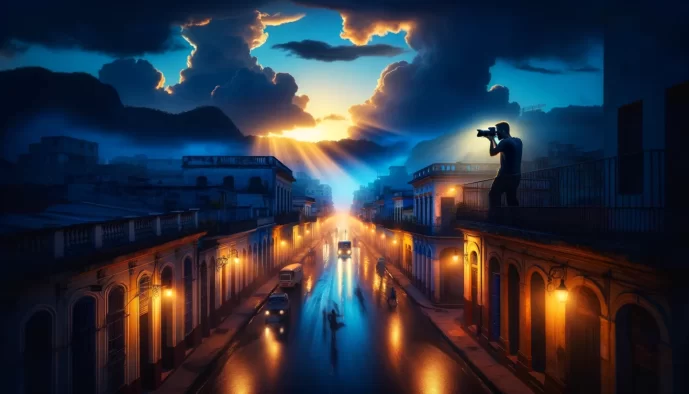Blue Hour Photo Guide
Master the magic of blue hour photography with our expert tips and techniques guide.

Introduction to Blue Hour Photography
What is Blue Hour?
Blue Hour refers to the twilight period just before sunrise and just after sunset when the sky is predominantly blue. This light is softer and more diffuse than during the day, casting a surreal glow that is prized by photographers.
Importance of Blue Hour in Photography
Photographers covet Blue Hour for its rich, saturated colors and balanced light. This time of day offers a brief window where the low light conditions add mood and depth to photographs without the harsh shadows or highlights that can mar midday shots.
Preparing for Blue Hour Shoots
Understanding the Timing
The duration of Blue Hour varies depending on geographic location and time of year. Use apps or websites like The Photographer’s Ephemeris or Blue Hour Calculator to predict the timing precisely.
Scouting Locations
Scout locations during daylight to anticipate how light will interact with the landscape. Look for unobstructed views, interesting architecture, or natural features that could enhance your composition.
Necessary Gear
A sturdy tripod is non-negotiable for stability in low light. A remote shutter release or camera timer can prevent camera shake. Also, pack extra batteries and memory cards—long exposures can drain power and storage quickly.
Camera Settings for Blue Hour
Manual vs. Automatic Modes
Manual mode gives complete control over the exposure triangle—ISO, shutter speed, and aperture. Auto mode can struggle with the dynamic range during Blue Hour, often leading to underexposed shots.
Optimal Exposure Settings
Start with an ISO between 100-400 to minimize noise. Aperture will depend on your depth of field requirements, but f/8 is a good starting point. Shutter speed will vary; use a slow shutter to capture enough light, checking the histogram to avoid overexposure.
White Balance Tips
Auto white balance may render the scene too warm. Setting white balance manually to the ‘Tungsten’ or ‘Fluorescent’ presets can retain the blue tones that define this hour.
Composition Techniques for Blue Hour
Using Silhouettes
Contrast between the dark silhouettes and the blue sky can create a dramatic effect. Position subjects against the lighter sky for a bold silhouette.
Incorporating Artificial Light
Streetlights, windows, and car lights begin to glow during Blue Hour, adding dimension and interest to urban landscapes.
Foreground Interest and Depth
Include elements in the foreground to create depth. This could be anything from rocks and vegetation to urban structures.
Post-Processing Blue Hour Photos
Enhancing Colors
Slightly boost the vibrance or saturation to enhance the blue hues without making the image unnatural.
Balancing Exposure
Use gradient filters or dodge and burn techniques to balance the exposure between the land and sky if necessary.
Adding or Reducing Noise
Apply noise reduction sparingly; too much can soften the image and remove detail. Shooting at a low ISO mitigates this issue.
Common Challenges and Solutions
Dealing with Low Light
A tripod is essential. If necessary, increase ISO but be mindful of noise.
Capturing Sharp Images
Use manual focus if autofocus struggles in low light. A tripod and remote shutter release can also help maintain sharpness.
Managing Moving Subjects
For moving subjects, a higher ISO or wider aperture may be required to achieve a faster shutter speed and freeze motion.
Inspiration and Ideas
Urban Landscapes
Buildings and bridges bathed in ambient light against the blue sky can create a stunning contrast.
Seascapes and Water Reflections
Capture the calmness of water during Blue Hour, with reflections adding symmetry and interest to the composition.
Portraits and People Photography
Use Blue Hour’s soft light for flattering portraits, or capture silhouettes for a more mysterious effect.
Conclusion
Summarizing Key Takeaways
Blue Hour provides unique lighting conditions that can bring a magical quality to photographs. By understanding the timing, scouting locations, and mastering camera settings, photographers can leverage this time to create breathtaking imagery.
Encouraging Practice and Patience
Photography during Blue Hour can be challenging but is incredibly rewarding. Experiment, practice, and patience are key to harnessing the potential of this ephemeral light.